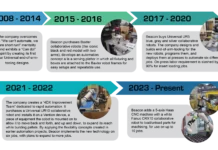by Chris Parrillo, Yushin America, Inc.

How are robotics utilized in the plastics processing industry?
Plastic processing companies, especially injection molders, are implementing robotics and downstream automation to increase productivity. This helps promote reduced cycle times, increased part quality and reduced costs. It can minimize operator risks from potentially dangerous and sometimes tedious tasks of removing parts from the machine, while also shifting manpower to jobs where those employees can add more value to the organization.
Processors are using robotics to generate cost savings; they are converting semi-automatic cycles to fully automatic cycles to increase production. More consistent cycles reduce process variability and increase the quality of parts. Controlled part removal reduces damage to parts that free-fall from the mold and also reduces mold damage by detecting that all parts have been removed from the mold before letting it close.
Robot sales to processors currently are at an all-time high, mainly because robots have become much more user-friendly. Today, shop floor personnel easily can set-up and program the robots. That has helped to reduce the cost of ownership over the past decade. These lower costs allow the smaller or mid-sized processors to take advantage of the automation wave. Everything from entry-level sprue pickers to separate runners from parts to completely automated flexible manufacturing cells are being installed by plastic processors.
What technology changes have been initiated as a result of the processing industry’s challenges?
The growth of the medical industry and cleanroom molding has required robot manufacturers to rethink their approach to mechanical designs. Robot drives must be clean and contained so they do not generate any type of particulate contamination to the cleanroom’s work environment. This means sealed bearings and belt drives are a must. Portable, soft cleanrooms can create overhead obstruction for the robot, so a low-profile telescopic main arm also is required. Yushin recently has installed a new cleanroom factory in Kyoto, Japan for manufacturing and testing of its robots. The Yushin YCII servo robot can operate in an ISO class 5 cleanroom with slight modifications added.
Short-run jobs are today’s norm for most injection molders. Robot controllers with simplified screens to reduce the number of icons an operator needs can speed changeovers, while also shortening the employee training cycle. Processors also want increased flexibility to help adjust with the multitude of future job types. They are ordering robots with additional arms, EOAT (end-of-arm tooling), quick change units and NC servo wrist flip units. The EOAT quick change allows a set-up technician to change an EOAT with the push of a button. All electrical and pneumatic connections then transfer over to the next EOAT.
The NC servo wrist is a versatile unit that gives the processor the ability to articulate the EOAT and manipulate molded parts incrementally to any position required. This is very helpful for difficult part removal, precise insert molding and visual inspection of hard-to-see part areas.
What trends does Yushin see in the use of robotics?
High-speed part extraction, especially in the packaging industry, is a popular trend today. Ultra high-speed extraction previously was achieved by fixed, dedicated side-entry-style robots. Today, versatile top-entry robots are able to achieve these same speeds. EOATs must have an optimized, lightweight mechanical design and vibration control technology to work within tight mold openings with no vibration at the end of the robot’s stroke. These robots can remove parts much faster than they can fall clear of the mold. Cavity segregation and improved part quality add additional value to the process. Recently, Yushin exhibited the HSA-150S robot at the K Show in Dusseldorf, Germany. It removed 16 parts from a mold in 0.27 seconds.
Another trend is beside-the-press automation. Molders are being asked to add more value to the parts right at the press. Robots and downstream automation beside the machine make up a completely flexible manufacturing cell. The days of complicated automation are in the past; todays manufacturing cells are extremely versatile and flexible. These manufacturing cells are being used for a wide variety of value-added processes, including decoration, degating, assembly, quality inspection (including visual inspection and dimensional gauging) and packaging into boxes, totes or trays to transport parts to an end user or another area of the factory.
Chris Parrillo is national sales manager for Cranston, RI-based Yushin America, Inc. (YAI). The company offers a wide range of automation technology for the plastics industry, ranging from individual part-removal robots and end-of-arm-tooling to fully integrated factory automation for assembly, decoration, inspection and packaging. Yushin America stands behind its products with a comprehensive parts inventory, regional service and 24/7 phone support, 365 days a year. Yushin America is the largest subsidiary of Yushin Precision Equipment Co, Ltd. of Japan, one of the world’s foremost suppliers of robots for the injection molding industry. For more information, visit www.yushinamerica.com.




